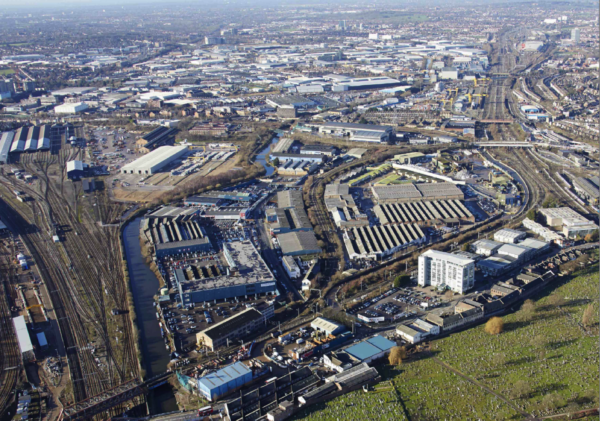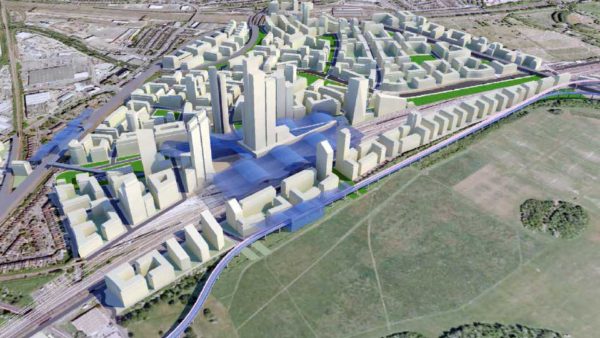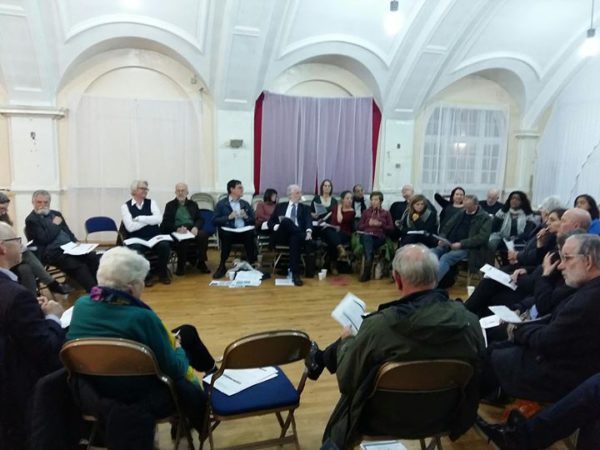Governing the Future City – the Redevelopment of Old Oak Park Royal, London
Governing the Future City is an international ESRC-funded project looking at innovative approaches to urban governance and planning in Johannesburg, London and Shanghai. This blog, following on from an introductory article, an overview of research in the area of Lingang near Shanghai, China and a case study of the Corridors of Freedom urban development programme in Johannesburg, South Africa, examines the development of the Old Oak Park Royal in London, one of the UK’s largest regeneration projects, and the complex financial and decision making processes underpinning its construction.

The Old Oak Park Royal area covers 650 ha of land in West London land straddling the boroughs of Hammersmith & Fulham, Ealing and Brent. The programmed arrival of HS2 and Crossrail and the creation of a ‘transport super-hub’ at Old Oak Common, where the two lines will intersect, is described by government as an unprecedented opportunity to spur regeneration in the area. The Old Oak Park Royal area is expected to accommodate 25,500 new homes and 65,000 jobs, making this one of the largest regeneration projects in the UK. The former Mayor of London exercised his power to establish the Old Oak and Park Royal Development Corporation (OPDC), now the second Mayoral Development Corporation in the capital, which became the planning authority and regeneration agency for the 65O hectare site on 1 April 2015.
Prospects of improvements in accessibility, coupled with the reallocation of some industrial land uses to allow residential and commercial development, have had the effect of altering the profitability surface for developers in the OPDC area. The presence of about 11,000 units in the planning system 20 months after the setting up of the OPDC testifies to this change. Compared to other projects, including the development of the Olympic Park, limited central government financial support is envisaged, meaning discussions about how to fairly share uplifts in land value resulting from the granting of planning permission are now urgent. To date, there is a lack of clarity about the precise level of public investment likely to be engaged, for instance, to improve the local transport network (including new bridges and roads). This uncertainty has been evoked by developers and their advisors to justify what they claim is their limited capacity to contribute to the delivery of social infrastructure.
The OPDC has been tasked with ensuring the Mayor’s vision for the site is realised. Yet, regeneration outcomes will also be dependent on the actions of other stakeholders with interests in the locality and on the partnerships those may enter.
Firstly, central government’s actions are likely to impact on the nature of the scheme and the social benefits derived from the redevelopment activities. 70 percent of the core development land (96 ha out of 134 ha) is in public ownership, but increasing pressure for all public bodies to self-finance could result in the sale of the land currently owned by the Department for Transport to private developers, with the risk of development occurring in a piecemeal fashion. Consequently, the former Mayor Boris Johnson signed an agreement in 2016 with the government to have all public land transferred to the OPDC. The terms of the deal have since been reviewed by the Greater London Authority on behalf of the newly appointed Mayor and deemed unfavourable, as its land would be acquired at market value. A challenge the OPDC and central government are still facing is how to reconcile the need to extract the most economic value from government-owned assets – to make up for the absence of public funds to carry out their respective activities – with the desire expressed by the new Mayor Sadiq Khan to maximize the delivery of affordable housing units on site.

Secondly, while the setting up of a mayoral corporation has resulted in planning powers being taken away from the local authorities originally in charge of approving development in the OPDC area, there is a clear stated intention to have local authorities as a central partner. The opportunity to shape development in the OPDC is afforded to local municipalities’ representatives through their membership of the OPDC governance structures; borough leaders sit on the OPDC Board, while four out of the eight members of the Planning Committee hold a local electorate mandate.
Thirdly, local residents and business groups may use different means, such as channels set up by the State, to influence the future of the area and how it is produced. Besides being awarded the task to determine most planning applications in the area, the OPDC is responsible for the development of new planning policies for the area to guide developers when they formulate their proposals. A first round of statutory public consultation was carried out on the draft Local Plan in Spring 2016 and the OPDC stage 2 consultation will be completed later this summer. The prospect of a new high-density mixed use district being developed on brownfield land close to low-density residential suburban neighbourhoods has also generated bottom-up initiatives to shape development. This includes the setting up of a network of a community and residents groups – the Grand Union Alliance – to share information and enhance their understanding of plan formulation mechanisms, as well as support each other to input collectively or individually into the local authority consultation exercise. Other initiatives include the formation of three neighbourhood forums with the ultimate goal to produce and secure approval for a neighbourhood plan that reflects its members’ vision for the area, while adhering to policy guidelines set at higher-level.

The research project will document ways in which a variety of actors work together to reach and implement a common vision for the development of a ‘new’ London district. It will pay attention to both the formal and informal arrangements relied upon to ensure the delivery of property development projects and socio-economic regeneration programmes. Secondly, the research will discuss how the costs and benefits associated with the project are shared across partners and sectors, highlighting how funding mechanisms currently available to UK cities may shape such distribution. Lastly, we will endeavour to identify the extent to which ideas from elsewhere circulated through networks of experts have influenced the future imagined for that new city district and the tools chosen to deliver this vision.